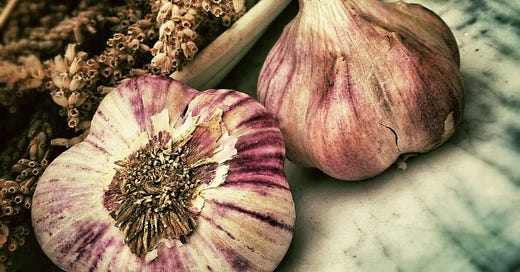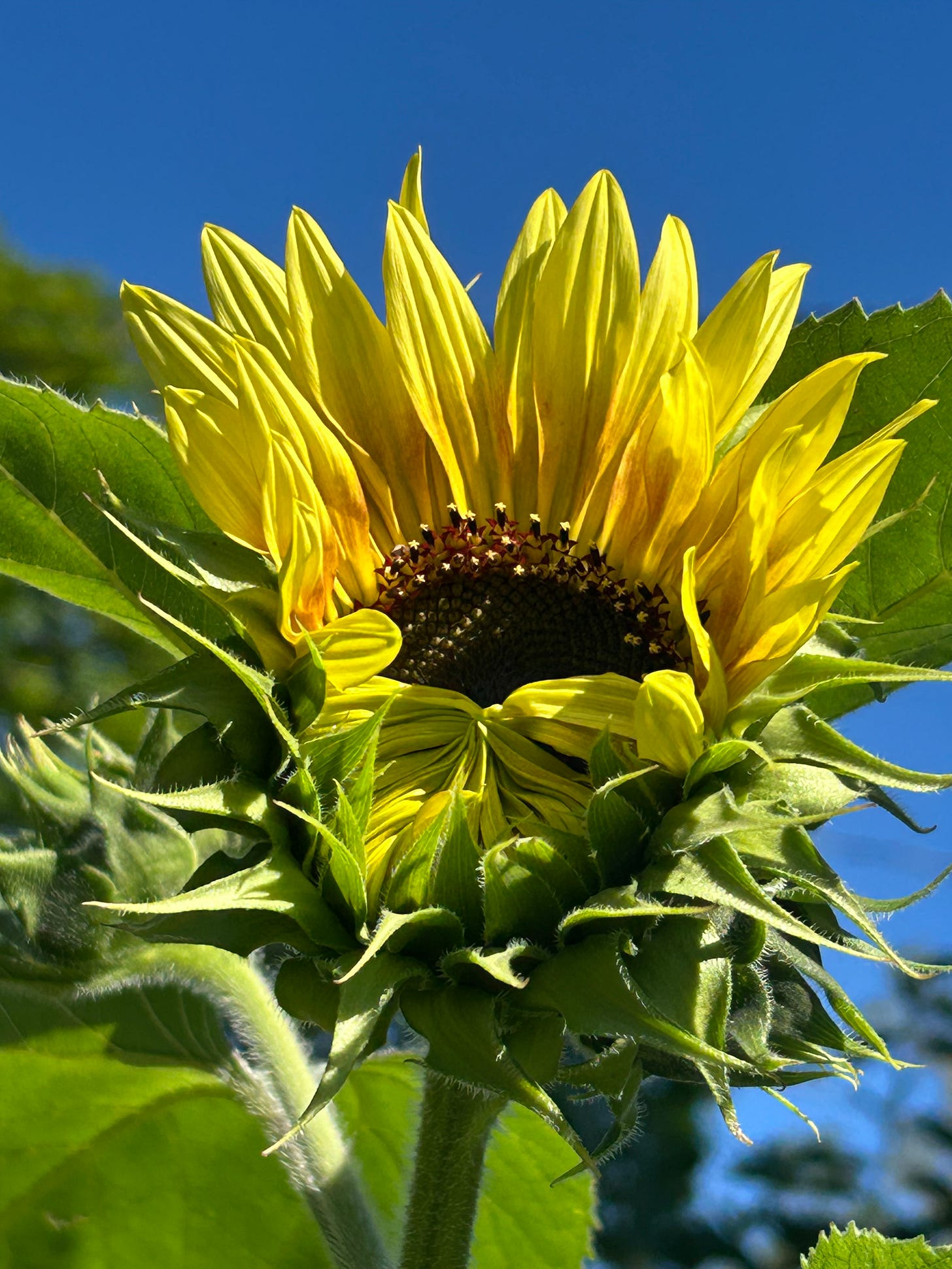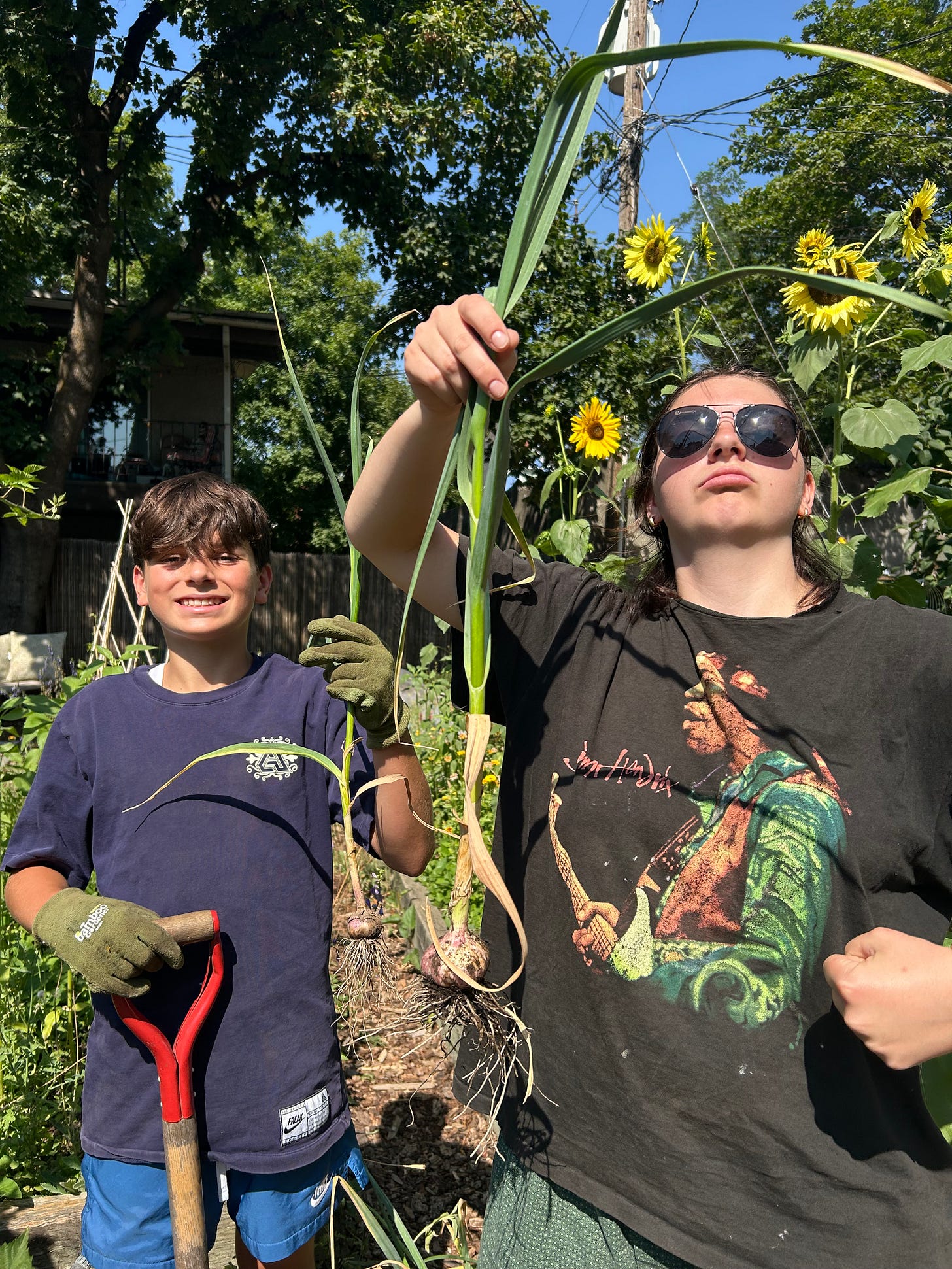
Welcome to Pocketful of Prose, a community for sharing stories. As always links are in bold, and there’s an audio of this post if that works better for your life. If you like it here, please share this pocket with a friend. You can do this by clicking the share button below, or you can send the link to them over text, or you can highlight Pocketful of Prose on your social media page. Thank you for being here!
Without further ado, today’s pocket.
In one of my garden beds, the center one, the sunflowers are taller than me. In fact, they tower above me. If they were next to my house, they’d reach the second story. For weeks now, the sunflowers have been the garden’s main attraction. No matter where you stand in the garden, the majestic sunflowers draw your gaze. This will probably continue until summer’s end.
I love sunflowers. They are bold, bright and hopeful. Their stalks provide places for songbirds to rest and hide, and when their flowers are spent, their seeds provide food to nourish my chirping friends. Sunflowers offer a detox for the soul, and they also detox the soil. Studies have shown that sunflowers can remove toxins like arsenic and even uranium from the soil.
In the garden bed adjacent to the central one, there are more sunflowers. The squirrels and birds never pick the flowers dry, and the seeds that remain on the stalks fall to the ground and reseed my garden come Spring. Sometimes, the squirrels and birds drop some of their pickings, and the sunflowers pop up in places that surprise me. The sunflowers in the second garden bed, and the ones adjacent to it, haven’t bloomed yet though. They are healthy and growing, but they are about a third of the size of the sunflowers in the center bed. Both garden beds contain similar soil, both receive the same amount of light and water, and both started from similar seed, so what gives? This is not the first time that my garden has invited me to be a scientist.
I do a little research, and my hypothesis is that sunflowers in the central bed are growing faster, taller and thicker because of the company they keep.
The sunflowers that tower over me and the rest of the garden like queenly protectors, whose stalks are thick and sturdy. These sunflowers are growing among the rows of garlic Dan and I planted in the fall.
So, the answer to the question, what gives, is garlic. It’s the garlic that gives.
Dan’s family is Italian and so garlic is an essential ingredient in most every meal we cook. It flavors everything from aglio e oglio, a pasta made with garlic, olive oil, hot pepper and fresh herbs, to the sauce we make for the baked ziti to the broccoli, mushrooms and even the brussels sprouts and scallions that we serve on the side of main dishes. Garlic is our go to, a staple we can count on, a comfort food.
I am used to doing many of the garden tasks alone. I’m not working in the summer, and the garden is my Zen, my joy, so I don’t mind, but I always invite my family to join me in the garlic tasks, because garlic is so central to our lives. Garlic is special, and it deserves a different kind of attention.
Garlic is planted in the fall, after everything else has been harvested, and it’s time to put the garden to bed. The first season we planted garlic, Seabass and I ventured into the garden in the early evening, as it was growing dark. Seabass helped me measure how far apart to space each clove with a ruler. We needed a flashlight to see what we were doing. Seabass had the ruler positioned backwards, and I told him he should turn it around to make it easier to measure five inches, but he responded, “Nah, I’ll just measure from twelve to seven.” He was nine, so I was impressed with his ease for numbers. We made tiny holes, and he popped them in, and I turned them around to position them just right.
In the Spring, garlic shoots are the first to appear in the garden. They are the first signs of life after a long dormant season, a reminder that winter doesn’t last forever. By early June, garlic scapes appear, circular shoots that can be harvested to make garlic scape pesto, which should immediately be lathered on sandwiches. My family looks forward to this delicacy every year. I have shared my garlic scape pesto with a few friends, and every time they say it’s the best sandwich they’ve ever had. I have never seen garlic scapes in a grocery store.
In July, the garlic is harvested. This requires a shovel to loosen the soil and a child, who is now a teenager, to gently tug the bulb from the soil. This year, we had to be extra careful not to disrupt the sunflowers. We accidentally dug up a few but we asked forgiveness and were mostly able to repair the damage.
My family and I LOVE garlic, but it wasn’t until this year that I realized how much garlic loves us back. Garlic is a giver, an excellent fertilizer, full of phosphorous and potassium. Garlic is the reason why my sunflowers reach the height of Anna and Seabass’ second story bedrooms.
In early Spring, it’s impossible not to notice the garlic as they are the only signs of green in a brown and barren land. In mid-July, though, you might miss them, growing among the glorious golden showstoppers.
My heart remains forever grateful to garlic, though, and all the givers.
Perhaps you know people who give like garlic, people whose life and work deeply enriches the lives of others. Our friend and landlord Sue in Madison is one such person. She wielded a broom and protected the songbirds’ nests from the sparrows, ensuring their safety. She took us under her wing and kept us company after we drove away from everything that was familiar to us.
Ms. Lyle, Mateo’s kindergarten teacher, is another such person. “He wants to be oh so good,” she would say to us often when there were oh so many other things she could have said. Her consistent kindness and sense of humor helped Dan and me, newly hatched foster parents, relax. She saw the good in Mateo, and because of that, he saw the good in himself.
Across the street from our house is a large apartment building where sadly one of our neighbors was recently evicted. All their belongings were put out on the street, and the management company just left it there. They didn’t send a truck to pick it up. Throughout the day people came and scavenged through the stuff, but much of it became garbage that blew up and down the street. Our street looked like it was hit by a storm of stuff. The next morning at seven am, I saw some women in front of the building sweeping. I asked one of them if they owned the building. “No,” she said, “but I live here.” She had returned home after working the night shift, and she grabbed a broom and started cleaning up the mess, a mess she didn’t make. With the help of one or two of her neighbors, they had things righted in an hour.
We live here.
It’s easy to become overwhelmed with the mess that’s been made, and sometimes we fall into despair.
This fall, I will hold one clove in my hand at a time, and I will pass this clove to someone I love, and together we will plant garlic.
I would love to continue this conversation in the comments. What resonates with you? What’s growing in your garden that’s bringing you joy? Who do you know that gives like garlic?







"It’s easy to become overwhelmed with the mess that’s been made, and sometimes we fall into despair." Such true words for the season we are all living through, one that feels never-ending. I so appreciate your antidote to the despair, and I think I will never look at garlic in quite the same way again.
Sunflowers bring such joy, garlic such warmth. Thanks for the companion planting idea!